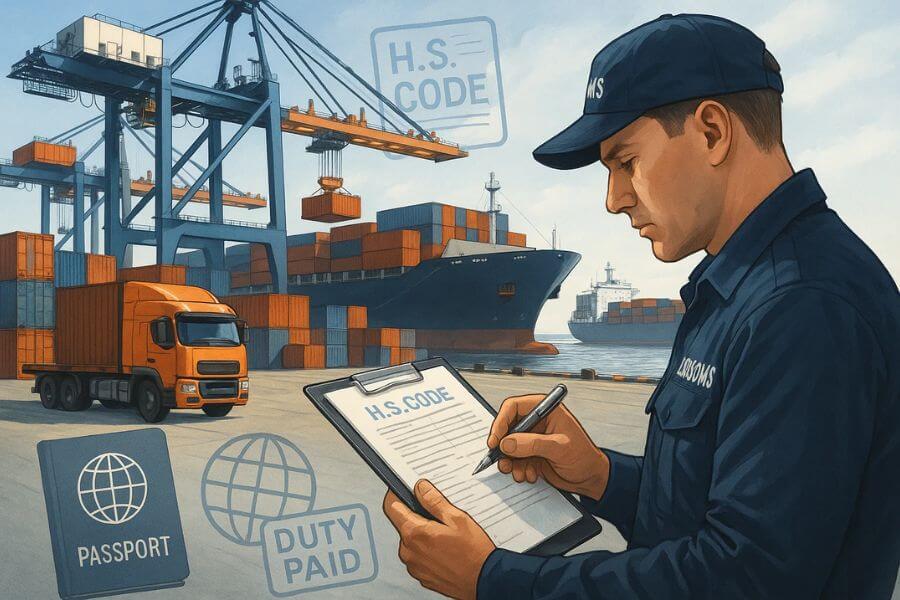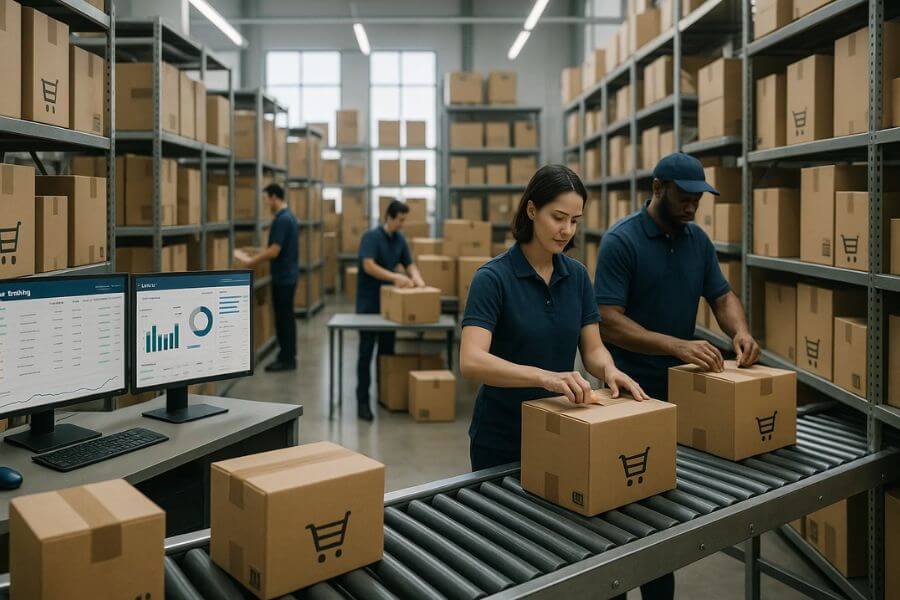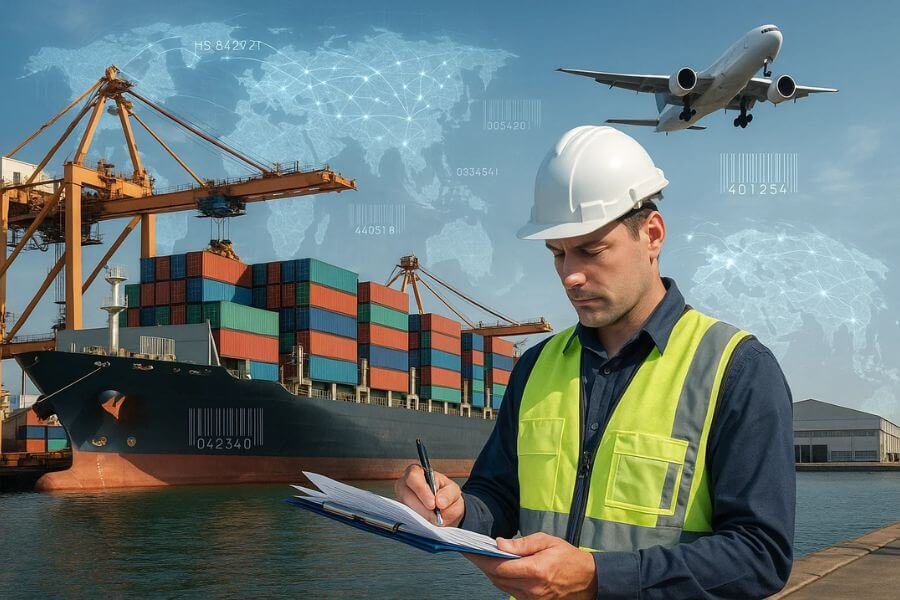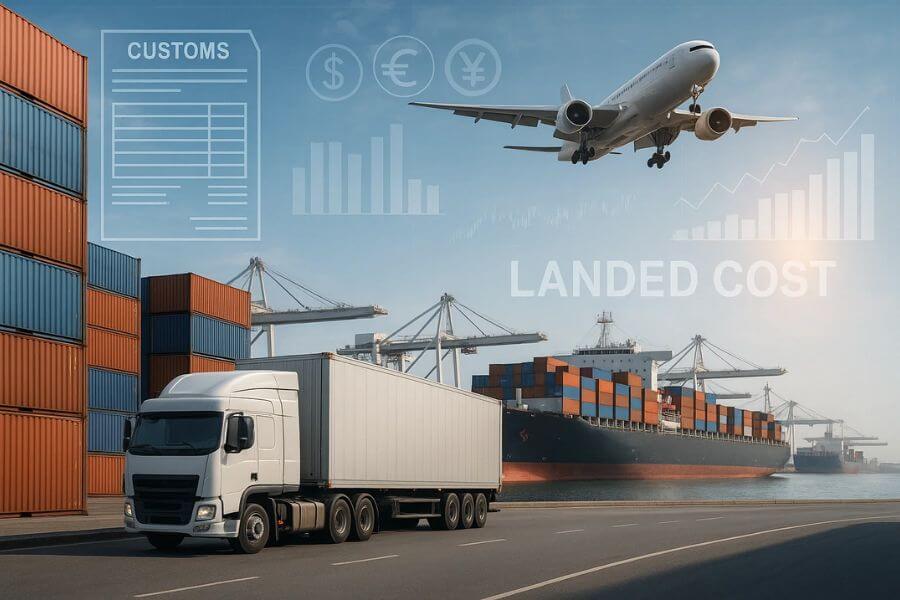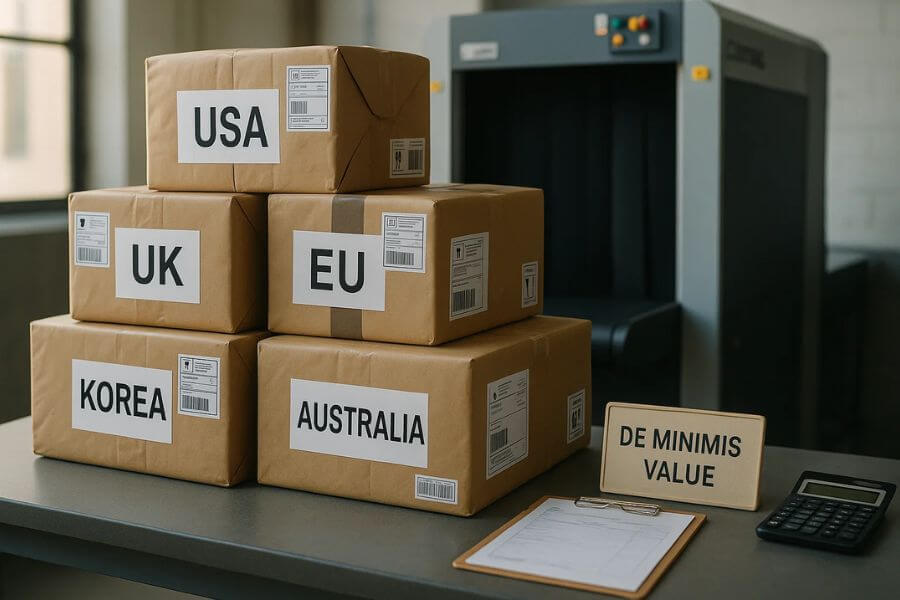Customs duty is a cornerstone of international trade, influencing pricing, supply chain efficiency, and compliance. For businesses that import or export goods, a deep understanding of customs duty is essential. It affects profitability, operational efficiency, and legal compliance.
In this guide, we’ll provide a thorough exploration of customs duty in logistics, including types, calculation methods, documentation, strategies to reduce costs, and the latest trends shaping the global trade landscape.
What is customs duty?
Customs duty is a tax levied by governments on goods imported or exported across international borders. Its primary purposes are to generate revenue, protect local industries, and regulate trade. While it can appear as a simple tax on paper, in practice it involves complex rules that vary across countries, depending on trade policies, product types, and tariff agreements.
Customs duty can take several forms:
- Ad valorem duty: This is calculated as a percentage of the value of goods. For example, a 10% duty on a $5,000 shipment would be $500.
- Specific duty: Charged per unit, weight, or volume. For instance, a $2 duty per kilogram of imported rice.
- Compound duty: Combines ad valorem and specific duties. For example, $1 per item plus 5% of the item’s value.
Understanding customs duty is essential for planning budgets, forecasting landed costs, and avoiding costly delays. Businesses that fail to accurately account for customs duty may face unexpected fees, fines, or shipment rejection.
How does customs duty work in logistics?
Customs duty is an integral part of logistics, particularly in international shipping. When goods cross borders, customs authorities ensure compliance with regulations, assess applicable duties, and authorize clearance.
The process typically involves several key steps:
- Customs declaration: The importer or their customs broker submits documentation detailing the shipment, including the product description, HS code, quantity, value, and origin. Accurate information is critical; errors can trigger inspections or fines.
- Duty assessment: Customs authorities calculate duties using the product classification (HS code) and value. They also check for preferential rates under trade agreements or exemptions.
- Payment and clearance: Once duties are paid, goods receive clearance for delivery. Delays in payment can stall the supply chain and result in storage fees at customs facilities.
Efficient management of customs duty can prevent bottlenecks in the supply chain. Many logistics providers now integrate customs clearance services directly into their workflows, ensuring faster processing and fewer errors.
What are the different types of customs duty?
Customs duties vary widely, depending on the country, product, and trade agreements. Understanding the different types helps businesses anticipate costs and choose effective logistics strategies.
Import duty
Import duty is applied to goods entering a country. Rates vary depending on the type of product, its value, and country of origin. Electronics, textiles, and agricultural products often have different duty rates. Some countries exempt certain goods under a minimum value threshold.
Export duty
Export duty is less common but imposed by some countries on goods leaving the country. It is typically applied to protect natural resources or control critical materials. For instance, rare minerals or crude oil may carry export duties to manage domestic supply.
Anti-dumping duty
Anti-dumping duties are levied on goods priced below fair market value by foreign producers, protecting domestic industries from unfair competition. For example, steel or aluminum imported at unusually low prices may trigger anti-dumping measures.
Excise duty
Excise duties target specific goods like alcohol, tobacco, or fuel. They can apply to both domestic and imported goods, and the rates are often significant, impacting pricing and logistics decisions.
Tariffs under trade agreements
Countries often negotiate free trade agreements (FTAs) to reduce or eliminate tariffs on certain goods. For instance, the United States-Mexico-Canada Agreement (USMCA) provides duty-free access for many products. Utilizing FTAs effectively can dramatically lower customs duty costs.
How is customs duty calculated?
The calculation method depends on the type of duty, the product, and the country of import. Common approaches include:
1. Value-based calculation (Ad valorem)
Customs duty = CIF value × Duty rate (%)
- CIF = Cost + Insurance + Freight
- Example: Importing goods worth $10,000 with a 5% duty → $10,000 × 5% = $500
2. Specific duty calculation
Customs duty = Quantity × Duty rate per unit
- Example: 200 kg of a product with $3/kg duty → 200 × $3 = $600
3. Compound duty calculation
Combines both value-based and specific methods.
- Example: $2/unit plus 5% of the total value.
Proper valuation, accurate classification, and complete documentation are essential to avoid overpayment or penalties. Many countries also consider additional taxes like VAT or sales tax in the total duty calculation.
What are harmonized system (HS) codes?
HS codes are globally standardized numeric codes used to classify goods in international trade. They are crucial for determining duty rates and complying with customs regulations.
- Structure: Each code has six digits, representing the product category, subcategory, and specifics. Some countries extend it to 8–10 digits for further detail.
- Importance: Correct HS codes ensure accurate duty calculation, compliance with import/export laws, and proper reporting for trade statistics.
Incorrect HS codes can lead to shipment delays, fines, or even seizure of goods. Using automated classification tools or consulting with customs brokers helps minimize these risks.
What are common customs duty challenges in the logistics industry?
Businesses often face challenges that increase the complexity of customs duty management:
- Complex regulations: Customs rules vary by country and change frequently. Continuous monitoring is required to ensure compliance.
- Misclassification of goods: Errors in HS codes or product description can result in higher duties or penalties.
- Delayed shipments: Incomplete documentation or customs disputes can cause shipment delays, impacting supply chain timelines.
- Hidden fees: Handling, processing, and inspection fees can add to customs costs beyond the duty itself.
- Trade restrictions: Certain goods may be restricted, requiring special permits, certificates, or licenses.
Proactive management and expert guidance help companies navigate these challenges efficiently.
What are some strategies to minimize customs duty?
While customs duty cannot be avoided, businesses can adopt strategies to reduce costs:
Leverage trade agreements
Free trade agreements and preferential trade programs can lower duty rates. Businesses should identify applicable agreements and maintain certificates of origin to qualify for reduced tariffs.
Accurate product classification
Correct HS code classification ensures duty is calculated properly. Automated systems, customs brokers, and periodic audits can prevent errors.
Proper valuation
Duties are often based on CIF value. Ensuring invoices accurately reflect product cost, insurance, and freight prevents overpayment.
Use duty drawbacks and refunds
Some countries allow refunds for re-exported goods or exported materials used in manufacturing. Duty drawback programs reduce net costs significantly.
Optimize shipping and packaging
Efficient packaging reduces volume and weight, lowering weight-based duties and associated fees. Consolidated shipments can further minimize costs.
Plan for tariff changes
Monitoring trade policies and tariffs allows businesses to adjust sourcing, shipping routes, or suppliers ahead of changes.
What are the required documentation for customs clearance?
Correct documentation is essential for smooth customs clearance. Key documents include:
- Commercial invoice: Lists the goods, value, and transaction details.
- Packing list: Describes packaging, quantity, and weight of goods.
- Bill of lading / airway bill: Proof of shipment.
- Certificate of origin: Confirms product origin for duty rates or trade agreements.
- Import/export licenses: Required for regulated goods.
- Insurance certificate: Covers potential damage or loss during transit.
Incomplete or inaccurate documentation is a leading cause of customs delays and penalties. Proper record-keeping is essential for efficient logistics.
What are some emerging trends in customs duty and logistics?
The landscape of customs duty and international logistics is constantly evolving, driven by technological advancements, changing trade policies, and global economic shifts. Understanding these emerging trends helps businesses stay competitive and compliant while optimizing costs.
Digital customs systems
Governments worldwide are increasingly adopting electronic customs declarations, automated risk assessments, and digital verification systems. Digital customs platforms reduce human errors, speed up processing times, and allow importers and exporters to track shipments in real-time.
Example: Countries like Singapore, the United States, and the European Union have implemented electronic filing systems such as the Automated Commercial Environment (ACE) and the EU’s Automated Import System (AIS). These systems enable faster clearance, pre-arrival processing, and easier integration with logistics software.
Tariff adjustments and trade wars
Global trade is highly dynamic. Shifts in trade agreements, political tensions, or trade wars can lead to sudden changes in tariff rates. Businesses that fail to monitor these changes risk paying higher customs duties, losing competitiveness, or facing supply chain disruptions.
Example: The U.S.-China trade tensions led to new tariffs on several product categories, affecting electronics, apparel, and agricultural products. Companies that had flexible sourcing and supply chain strategies were able to mitigate these impacts.
Sustainability and green logistics
Environmental concerns are increasingly influencing customs regulations. Some countries now track carbon emissions related to shipping, while others impose eco-taxes or require compliance with green logistics standards. Businesses that adopt sustainable shipping practices may benefit from incentives or preferential treatment at customs.
Example: The European Union is considering carbon border adjustment mechanisms, which could affect the duty calculation for high-emission imports. Companies adopting eco-friendly packaging, energy-efficient shipping, or carbon-neutral transport may gain an advantage.
AI and automation in customs compliance
Artificial intelligence and automation are transforming customs duty management. AI can help classify products accurately, predict duty rates, identify compliance risks, and flag potential delays before shipments reach customs. Automated tools also simplify document preparation and tracking, reducing human error and increasing operational efficiency.
Example: AI-driven software can automatically assign HS codes to products based on descriptions and images, significantly reducing misclassification risks. Predictive analytics can also alert businesses to likely delays in specific ports or customs hubs.
Cross-border ecommerce expansion
The rapid growth of ecommerce has increased the volume of small parcels crossing borders. Customs authorities are adapting by implementing simplified clearance procedures for low-value shipments while maintaining stricter controls for higher-value goods. Businesses need to optimize packaging, labeling, and documentation to comply with these evolving standards.
Example: Many countries now allow pre-paid duties or automated declaration options for ecommerce shipments under de minimis thresholds, streamlining the process for online sellers and improving delivery times.
What are the best practices for managing customs duty?
Managing customs duty effectively requires a combination of strategy, technology, and proactive planning. Implementing best practices ensures compliance, reduces costs, and minimizes operational disruptions.
Continuous education and training
Customs regulations change frequently. Teams involved in import/export operations should receive ongoing training on tariff updates, classification rules, documentation requirements, and trade agreements.
Example: Conduct quarterly workshops or webinars with customs brokers to review regulatory changes and provide case studies of common errors.
Periodic audits and compliance checks
Regular audits help identify errors in HS code classification, valuation, or documentation. Detecting issues early prevents fines, penalties, and delayed shipments.
Example: A logistics team may schedule bi-annual audits of all shipments and duties paid, comparing them with updated trade regulations to ensure accuracy.
Leverage technology and automation
Customs software and AI-driven tools can automate calculations, track shipments, and generate accurate documentation. Integration with shipping and accounting systems ensures real-time visibility of duties and taxes.
Example: Automated landed cost calculators can include duties, tariffs, taxes, and additional fees, enabling accurate pricing for ecommerce platforms and reducing unexpected expenses.
Collaborate with customs brokers and logistics experts
Working with professionals ensures smooth clearance, accurate duty assessment, and compliance with complex regulations. Brokers can also help identify applicable trade agreements or duty exemptions.
Example: A U.S. importer can partner with a licensed customs broker to manage shipments from Asia, ensuring proper HS classification and utilizing preferential trade rates.
Risk management and contingency planning
Anticipate potential disruptions such as delays, tariff changes, or regulatory audits. Maintain backup suppliers, flexible shipping routes, and contingency budgets to mitigate risks.
Example: During sudden tariff increases, companies can shift shipments to alternate ports or adjust sourcing strategies to minimize cost impact.
Documentation standardization and organization
Keeping all shipping, customs, and insurance documents organized and standardized prevents delays and simplifies audits. Digital document management systems reduce errors and ensure easy retrieval.
Key takeaway: Combining knowledge, technology, professional support, and proactive planning provides a comprehensive approach to effective customs duty management.
Frequently asked questions about customs duty
Q1: Can customs duty rates vary by country?
A1: Yes. Each country sets its own customs duty rates, often influenced by trade agreements, economic policies, and product classifications.
Q2: How can small businesses manage customs duty efficiently?
A2: Small businesses can leverage customs brokers, software tools, and free trade agreements to reduce costs, ensure compliance, and simplify paperwork.
Q3: Are there exemptions or thresholds for customs duty?
A3: Many countries provide exemptions for low-value shipments, certain products, or under preferential trade agreements. Checking local regulations is essential.
Q4: What happens if customs duty is underpaid?
A4: Underpayment can result in fines, penalties, delayed shipments, or seizure of goods. Accurate classification and valuation prevent these issues.
Q5: How does customs duty impact pricing for consumers?
A5: Customs duty increases the landed cost of imported goods. Businesses must consider duties when setting prices to maintain profitability while remaining competitive.
Q6: Can customs duty be pre-paid by shippers?
A6: Yes. Some logistics providers offer pre-paid duty services, allowing importers to pay duties upfront, simplifying the clearance process and improving delivery speed.
Q7: How often do customs regulations change?
A7: Regulations can change frequently, sometimes multiple times per year. Monitoring updates and working with professionals ensures compliance.
Q8: What is the role of HS codes in customs duty?
A8: HS codes classify products internationally, determining the applicable duty rate and ensuring proper compliance with trade regulations.
Q9: Are customs duties refundable?
A9: Yes, in certain cases such as re-exported goods, manufacturing for export, or participation in duty drawback programs, duties may be refunded.
Q10: How does ecommerce affect customs duty management?
A10: High volumes of small shipments increase administrative tasks, but simplified procedures and digital solutions help streamline duty calculations, documentation, and clearance.
Summary
In summary, Customs Duty in logistics is a government-imposed tax on goods imported or exported across international borders, calculated based on their value, quantity, or classification.

